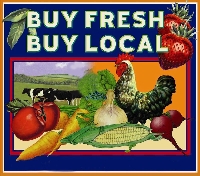
Wondering what is a local food movement? Look for answers close to home!
“Eat Local, Buy Local, Be Local”
That is the simple answer to “What is a local food movement?”
When you grow your own vegetables, raise your own beef, make your own cheese and pick fruit from the trees in your backyard you are engaged in the local food movement, whether you know it or not.
A local food movement aims to support the growing, purchase and consumption of locally grown foods. Additionally, it promotes and supports urban (city) gardens, community gardens, backyard gardens and local farms and farmers? markets.
When you buy locally, frequently you are buying from farmers who engage in sustainable agriculture. This involves methods of food production that do not harm the environment, are healthy practices and humane to animals. This type of farming includes fair wages to farmers, supporting the farming community and buying food as locally as possible.
JOINT EFFORT
A local food movement is a joint effort to build more locally-based and self sufficient food economies. People are now looking for food that has traveled fewer miles and which has a distinguishable origin. You know where your food came from.
“Local food” can mean anything that was grown within a 100 mile radius or a 400 mile radius, depending on whom you ask. Another way of explaining the local food movement is to define it as the development of a connection between people and the subsequent relationships that are formed.
~
SUSTAINABILITY
When a farmer, who is local to someone, uses sustainability practices this benefits him, the local economy and community. It also benefits the environment through air and water quality protection, reducing energy consumption and enriching the soil in the area. Food production actually increases when farmers use sustainable practices and the effects on the climate due to carbon sequestration are reduced.
Sustainable relates to, or is a method of, harvesting or utilizing a resource or resources so that the resource is not permanently damaged or depleted. Those who are on-board with this create a lifestyle where they use sustainable methods, such as gardening and recycling.
Many people are so accustomed to running to the grocery for their every food need that it may not have occurred to them that they could grow some of it – especially a vegetable garden – themselves. In the process, they will eat healthier, learn a new vocation, work toward a more sustainable future as well as reduce pollution.
INDUSTRIAL LEVEL FOOD PRODUCTION
When food is produced on an industrial level this requires the use of fossil fuels. These fuels when refined and burned result in greenhouse gases that are major contributors to climate change. However, industrial farming itself and the transportation or fueling of machinery is not the biggest user of fossil fuel.
Forty-percent of the energy that is needed in industrial food production goes toward the production of chemical pesticides and fertilizers. Industrial farmers contribute greatly to air and water pollution.
Additionally, when food is processed, a tremendous amount of plastic and paper packaging is needed to keep the food fresh while it is being transported and then stored somewhere.
If a state grows 10 percent more local produce this reduces the use of fuel tremendously and also reduces C02 emissions.
JOINING THE MOVEMENT
When a community decides that it is going to grow and consume local foods, a concerted effort is made to preserve the land on which they live and work. Natural habitats are maintained, such as wetlands and forests.
When food is sold and purchased locally, less packaging materials are used and food is only harvested when it is ready to be eaten and not long before.
When a farmers? market crops up in your locale this enables you to eat seasonally — fresh vegetables right out of the garden ? and it?s certainly a topnotch way to learn about the agriculture in your area. Furthermore, you are supporting the farmers in your area.
